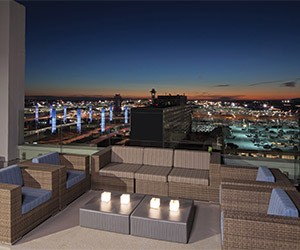Say goodbye to traditional front desks, room keys, bland banquet fare, generic design and bare-bones workout facilities. Say hello to digital check-in, keyless guest room entry, expansive fitness centers, socially oriented public spaces and an emphasis on the unique and local in everything from break snacks to hallway art and shampoo.
At many hotels, the guest experience is undergoing transformation. Here are a few of the ways.
Health and Wellness
Going beyond including a yoga mat in the room, hotels are digging deep to address the health and wellness concerns of guests these days, according to analyst Bjorn Hanson, clinical professor at NYU’s Jonathan M. Tisch Center for Hospitality and Tourism.
"The concern with wellness is being seen even in how hotels are built and designed, including a trend toward natural fibers in the guest rooms and consideration of the chemicals in cleaning products and carpeting,” he said. “Meeting planners are asking more questions about air purification and water treatment systems these days and hotels are taking steps to avoid disease outbreaks."
Hotel rooms that promote quality sleep and relaxation after a busy travel day are another trend. Among examples are the Wellness Rooms currently undergoing beta testing at Wyndham Hotel Group.
“We’re looking at details such as color, mattress firmness and ways to change the lighting throughout the day, starting with brightness in the morning and then dimming and growing more soothing by evening,” said Carol Lynch, global vice president of sales for Wyndham Hotel Group. “We’re also looking at scented humidifiers that provide an almost spa-like experience.”
Hotel experts also note that hotel fitness centers are growing more extensive.
“Hotel fitness centers used to be a perfunctory afterthought—a converted guest room with minimal equipment and ambience,” said consultant Robert Mandelbaum, director of research information for CRBE Hotels. “Now it’s much larger and elaborate. People expect to be able to work out on the road and they want to replicate what they can get at home.”
At a growing number of hotels, guests don’t even have to leave their rooms to get a workout. Among examples is Five Feet to Fitness, a wellness concept available at Hilton hotels in major cities, where selected rooms offer Fitness Kiosks with touch-screen displays of workout tutorials, indoor bikes and a Gym Rax functional training station.
Meanwhile, MGM Resorts International was one of the first hotel companies to strategically incorporate a wellness experience for guests and attendees with the launch of its Stay Well Rooms and Stay Well Meetings at MGM Grand Hotel and Casino in Las Vegas.
The 250,000-square-foot expansion of the MGM Grand Conference Center, currently underway and set for completion by the end of 2018, will extend the Stay Well Meetings footprint by 22,000 square feet and encompass the conference center’s entire second floor.
The program, a partnership with Delos, the pioneer of Wellness Real Estate, is designed to provide environments for high-performance meetings, with function rooms and spaces designed to optimize the health and well-being of attendees while complementing the Stay Well room and suite experience.
The Stay Well program will also be part of Park MGM, another upcoming MGM Resorts development that is transforming Monte Carlo Resort and Casino into a property well suited to small groups seeking innovative spaces and experiences.
Going Local
While hotel companies once prided themselves on presenting a uniform experience at each property, the desire for authentic, local experiences among travelers has prompted many to launch brands where no two properties are anything alike. Examples include Marriott’s Autograph Collection and the new Curio Collection by Hilton comprised of four- and five-star properties in global locations.
“The Curio Collection was launched to meet travelers’ desire for local discovery,” said David Marr, senior vice president and global head of full-service brands for Hilton Hotels. “We encourage their individuality as an integral part of their destination.”
While independent hotels have long celebrated their locality, many are exploring new ways to do so. At Associated Luxury Hotels International (ALHI), which represents 250 independent hotels, a sense of place is a reflected in almost every aspect of the guest experience, according to Mark Sergot, chief sales officer.
“Locally sourced doesn’t just apply to the food served in the hotel restaurant but is evident throughout, whether it’s the snacks in the minibar or the bathroom amenities,” he said. “Hotels are going to creative lengths to celebrate their surroundings.”
As an example, Sergot points to the Salamander Resort and Spa in Middleburg, Va., where the owner’s personal art collection, some of it inspired by the surrounding horse farm country, gives the property a sense of place and individual flare.
Hotels are also getting creative in the recreational and cultural options offered to guests, both on and off the property, noted Andy Finn, vice president of group sales for Benchmark Hospitality. The hotel company’s Wanderlust program offers destination information and arrangements for guests, including meeting groups.
“We’re partnering more with area attractions to provide unique experiences for groups,” Finn said. “At The Chattanoogan in Tennessee we do events with a local whisky maker. At Eaglewood Resort and Spa near Chicago we take people to an indoor go-kart racing track that is really fun for teambuilding or we can do interesting things at the resort itself, including night golf with neon lighting.”
PageBreakUnconventional Fare
Few aspects of the guest experience are undergoing a bigger change than meal service for meeting attendees, according to Mike Schugt, president of Teneo Hospitality Group, which represents 300 deluxe hotels and resorts around the world.
“The drive for highly curated experiences has made its way to the banquet table,” he said. “Things have gone to a whole new level where chefs are preparing extraordinary dining experiences for thousands. For example, The Venetian in Las Vegas has done huge events where items on the menu include things like venison or elk and specialty cocktails.”
Finn also noted the change, adding that theme banquets have given way to more participatory events where attendees interact with the chef and sommelier.
“It might involve a chance to see the chef cooking or having the chef and sommelier come out and talk about the different items and where they were sourced,” he said. “Or the group might split into teams and work with the chef on various courses.”
At Wyndham’s conference-focused Dolce properties, banquet fare has taken a healthier, locally sourced turn, according to Lynch.
“Instead of coffee breaks we offer nourishment hubs, with an emphasis on healthy food for healthy minds,” she said.
At Hilton, initiatives such as Meet With Purpose emphasize fresh eating choices for attendees, according to Marr.
“The program features offerings that are not only healthy, but also fun,” he said. “One example is the Cut & Create salad available at Capital Hilton in Washington. A unique twist on the salad bar, it’s an interactive dining experience that lets guests clip fresh greens straight to their plates.”
Hilton properties are all about infusing culinary offerings with the healthiest local options around, such as a nutritious homemade juice station at Hilton Los Cabos Beach and Golf Resort, where options include a green juice made with celery, spinach and cactus, or a papaya juice.
JW Marriott properties also strive to incorporate local culture wherever possible in culinary offerings. At JW Marriott Tucson Starr Pass Resort and Spa, for example, group breakfasts can include eggs made to order with Indian fry bread and local chiles.
Open Spaces
The open-lobby concept with plenty of communal work space, informal gathering spots and outlets for recharging devices continues to be a strong industry-wide trend, according to Marr.
“We’ve seen a dramatic shift in guests requesting public space for both work and leisure use,” he said, something he believes is largely prompted by the fact that more people are working remotely and have less face-time with colleagues.
“These guests want to feel like they are part of a community and are looking for an open environment to sit and work while being surrounded by live energy rather than being relegated to a hotel room,” he added. “Restaurants located on the lobby perimeter often no longer have doors but rather an open entrance, so that the energy of these spaces can flow into the common areas.”
Beyond the lobby, open spaces on rooftops and other levels that offer open-air venues is an increasingly popular trend no matter where the property is located. The stylish new H Hotel Los Angeles at LAX, part of Hilton’s new Curio Collection, debuted in October with 168 rooms, a roof deck available for events and aviation-themed artwork by local artists.
The 1,000-room Marriott Marquis Houston, the latest property to debut in the destination, has one of the most innovative open-air venues that can be utilized for group events: a pool deck that overlooks George R. Brown Convention Center and the massive park in front and boasts a lazy river in the shape of Texas, multiple lounge areas and event spaces and an outdoor bar.
Tech Innovations
Mobile apps enabling guests to check into hotels and access their rooms with their smart phones is a huge trend. These include Hilton’s Digital Key app available to Hilton Honors members, which is currently in operation at over 2,500 properties, according to Marr.
“Guests can book a room, check in, choose their desired room from a digital floor plan set against Google Maps, access their rooms via Digital Key and request additional items to be in their room upon arrival,” he said. “With this technology, guests have the front desk, a concierge, a room key and event planner in the palm of their hand at all times.”
At Wyndham, where similar mobile check-in will soon be available, Lynch said the company is also developing ways for text messaging to provide efficient delivery of guest services.
“I was already able to use this service at the Wyndham New York,” she said. “I checked into my room and got a text from the front desk asking if there was anything I needed. I texted that I needed water and they replied with several options.”
Also influencing the guest experience is social media, including new technology that enables hotels to monitor guest feedback and make possible changes in response.
“It’s going far beyond seeing what guests are saying on TripAdvisor and other review sites,” Mandelbaum said. “Hotels are now able to instantly track what’s being sent out about them on Twitter, Facebook, Instagram and so on.”







